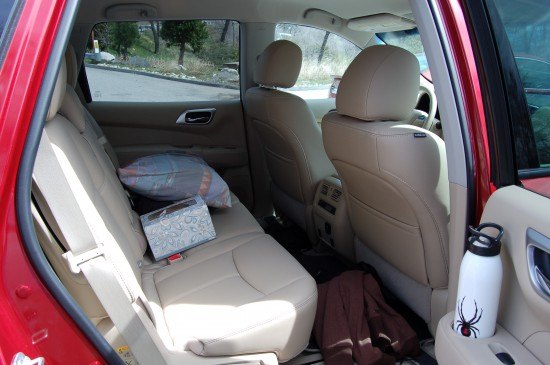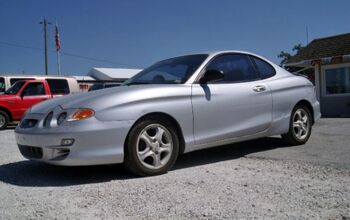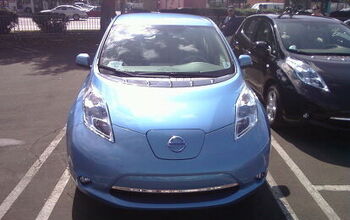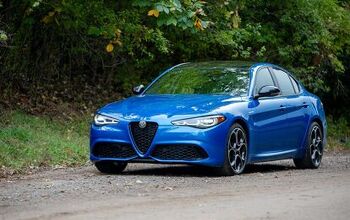Capsule Review: 2015 Nissan Pathfinder
Before you read this road test of the 2015 Nissan Pathfinder, I must write that it isn’t as comprehensive as I want it to be, even though I put well over 1,000 miles on it. There was supposed to be a road trip from San Jose to Lake Arrowhead with at least three other people on board. They were supposed to critique the car’s features, evaluate the interior comfort during the trip, and simulate the amount of stress that most families would put on a seven-passenger crossover. It wasn’t meant to be, though, with all three bailing out with various reasons, from studying to the CPA exam (a very valid excuse) to needing to visit family (again, a valid excuse) to saying they would come if the destination was changed to Santa Barbara (not a valid excuse and grounds for a passive-aggressive e-mail).
Such an experience was supposed to make up for the fact that actual, live families would potentially read this review of the Pathfinder and seriously regard what I, a childless, flip-flops-wearing, Gran Turismo-playing millennial, wrote about their possible next family car. “Oh, he actually carted around 4 full-size adults for over 1,000 miles rather than using it alone on his daily commute,” they would think, “This test really simulated family use. He probably even yelled at the back seat passengers to turn their music down.” Unfortunately, I never got my chance. Instead, the long trip consisted of tuning into Christian rock stations throughout the Central Valley while trying to find an alternative rock station, until I got to Pasadena, where I began loudly complaining to myself about traffic in Southern California.
But enough about Southern California traffic (and I could really go on), I must discuss the history Pathfinder nameplate. In 1985, Nissan debuted the Pathfinder, which was intended to compete with the Jeep Cherokee and Toyota 4Runner, though it was only available with two doors at launch. It was a very capable vehicle off-road and was built on a truck platform. It eventually gained two extra doors as well as a third seat in later generations while retaining the off-road capability of the original. The last-generation Pathfinder was even available with a V-8. But it became difficult to market as a family vehicle due to its body-on-frame construction, which didn’t help its fuel economy and limited interior space.
Other car platform-based seven-passenger family crossovers like the Honda Pilot, Toyota Highlander, Hyundai Santa Fe, and Mazda CX-9 were taking away sales from truck-based SUVs like the Pathfinder. The Pathfinder needed to be significantly updated for better fuel economy and better internal packaging for the needs of most families, many of whom didn’t need the extensive off-road and towing capabilities of the old Pathfinder.
As a result, my 2015 Pathfinder 4×4 test car is completely different from the old Pathfinder. It’s based on the same platform as the Murano and Altima. It handles better than the old truck-based Pathfinder and gets significantly better fuel economy largely due to its much lower weight. Its door handles aren’t on the C-pillar. The exterior design is a lot cleaner and a lot more rounded. The interior is a much nicer place to be and has more space to move around in. The transmission is continuously variable rather than having actual gears. The competition is now vehicles like the Pilot and Highlander rather than the 4Runner and Jeep Grand Cherokee.
Since I spent well over 1,000 miles in the driver’s seat, I’m going to first focus on comfort. As potential Pathfinder buyers will be spending a good deal of time behind the wheel, driving the kids to numerous activities like fencing and jai alai (kids really need to stand out for those college apps) and taking long road trips (jai alai tournaments are perhaps very few and far between), I can definitively write that the front driver’s seat of the Pathfinder is a satisfying place. There’s no other way I could have lasted six hours straight driving back from San Bernardino to San Jose without a long pause. Some sections of highways I drove on were very bumpy, yet the Pathfinder’s ride soaked up the bumps and didn’t provide a jarring experience. During the trip, I didn’t find out myself shifting around in the seat after 300 miles like I would in other cars. When I arrived home, I didn’t feel stiff and felt I had the energy to do things.
The back seat isn’t such a bad place either. There’s an easily accessible 120V power outlet for plugging in a laptop or other equipment and the second row can also control its temperature. It’s possible to recline the seats and relax. I wouldn’t recommend the second row for people well above six feet since there wouldn’t be enough legroom for them. Meanwhile, the third seat is strictly for two people who haven’t hit their growth spurt. Anyone above 5 feet and 5 inches would have a rough time sitting in the third seat after 90 minutes. Extra legroom can be derived by moving up the middle row, but then adults in the middle row would lose plenty of legroom and become uncomfortable too. All passengers in the back have their own air vents, so there’ll little question of keeping cool during the summer.
When it comes to cargo capacity, with the third row up, there’s enough room for two large suitcases and one airplane carry-on bag. There is some extra space for miscellaneous objects below the trunk which can accommodate two small backpacks. With the third row folded down, the cargo capacity substantially increases, making the Pathfinder a good match for four to five person road trips. The middle row folds down too, so the car can fit long surfboards and bikes inside rather than affixing them to the roof or an attachment to the tow hitch. Furthermore, the spare tire is mounted underneath the car behind the tow hitch, not impeding the interior cargo space.
To move all 4,500 pounds of the car, Nissan equipped the Pathfinder with the 3.5-liter V-6 which makes 260 horsepower and 240 lb-ft of torque, which is right in line with the V-6 options of the Pilot, Highlander, Kia Sorento, and Santa Fe. Unlike the competition, the Pathfinder’s V-6 is pared to a CVT, which helps considerably with the fuel economy numbers. The powertrain had no problem keeping up the very fast traffic on Interstate 5, with the car traveling between 75 and 80 miles an hour for two hours straight. Even from a stoplight, fully loaded the car doesn’t have trouble getting places.
A common complaint about the Pathfinder is its continuously variable transmission. For 2015, the CVT in the Pathfinder received “D-Step Shift Logic” which makes the CVT feel like a traditional transmission. During my time, I had no problems with it. The only thing I noticed involving the CVT occurred when driving on a particularly hilly section of highway (the Grapevine section of Interstate 5). The CVT was constantly trying to find the right planetary gear to climb up the hill, acting like a seven or eight-speed automatic transmission. Despite that, the transmission was still maintaining a constant speed of 65 mph, and didn’t have a problem with how much throttle I gave the car. However, the CVT didn’t have that issue when driving up the mountains to go to Lake Arrowhead, perhaps because of the lower speeds with the winding roads.
However, the fuel economy of the Pathfinder was exceptional, considering mine had four-wheel-drive and can seat seven people. Granted, the Pathfinder carried two people at most, and a majority of the miles I drove were on the highway in two-wheel-drive mode, with air conditioning off some of the time, but the Pathfinder managed a little bit over 25 miles per gallon, which is on the upper end of the EPA estimate of 19 city and 26 highway. The CVT definitely helped in achieving than figure.
As for utilizing the four-wheel-drive system on the car, I didn’t have a chance to do so. Unfortunately, no snow fell around Lake Arrowhead, and though taking the Pathfinder to my local off-road vehicle park was thought about, I didn’t think Nissan intended the current Pathfinder to face obstacle that even some current Jeeps have some difficulty completing. Nonetheless, Nissan’s intuitive 4WD system has 2WD, automatic, and 4WD lock modes as well as hill start assist and hill descent control. All of those features may come in handy when driving in snow or climbing and descending steep dirt or gravel roads.
My test car was the SL 4×4 model which had leather seats, a power passenger seat, power lumbar support, power liftgate, rear SONAR, a blind sport warning system, and a remote engine start system, useful for warming up the car in cold weather. Mine also had the SL Tech Package, which included navigation, a Bose sound system, the Around View monitor, and a tow hitch receiver with the trailer harness. With the $860 destination charge, the MSRP came to $40,850. Considering the amount of equipment on the Pathfinder, I think it’s very well-priced and the MSRP is very similar to other seven-passenger crossovers with a similar level of equipment as my Pathfinder test vehicle such as the Pilot Touring trim and the Highlander Limited model.
In the end, the Pathfinder should be on most families’ shopping lists. Those families who don’t want a minivan and are only willing to consider either a Honda Pilot or Toyota Highlander are missing out on a very nice interior, much cleaner and classier outside styling, and many, many features for the price. After over 1,200 miles with it, I can write the Pathfinder is an excellent vehicle for driving long distances. What I can’t write is whether four millennials can tough out 1,200 miles as passengers in a Pathfinder, which in hindsight, is for the best. Otherwise I’d be writing this review with a hoarse voice.
Satish Kondapavulur is a writer for Clunkerture, where about a fifth of the articles are about old cars and where his one-time LeMons racing dreams came to an end once he realized it was impossible to run a Ferrari Mondial. He’s still proud and amazed of the fuel economy numbers he achieved with the Pathfinder.
More by Satish Kondapavulur
Latest Car Reviews
Read moreLatest Product Reviews
Read moreRecent Comments
- Golden2husky The biggest hurdle for us would be the lack of a good charging network for road tripping as we are at the point in our lives that we will be traveling quite a bit. I'd rather pay more for longer range so the cheaper models would probably not make the cut. Improve the charging infrastructure and I'm certainly going to give one a try. This is more important that a lowish entry price IMHO.
- Add Lightness I have nothing against paying more to get quality (think Toyota vs Chryco) but hate all the silly, non-mandated 'stuff' that automakers load onto cars based on what non-gearhead focus groups tell them they need to have in a car. I blame focus groups for automatic everything and double drivetrains (AWD) that really never gets used 98% of the time. The other 2% of the time, one goes looking for a place to need it to rationanalize the purchase.
- Ger65691276 I would never buy an electric car never in my lifetime I will gas is my way of going electric is not green email
- GregLocock Not as my primary vehicle no, although like all the rich people who are currently subsidised by poor people, I'd buy one as a runabout for town.
- Jalop1991 is this anything like a cheap high end German car?















































Comments
Join the conversation
Every japanese scooter made since the early 80s has had a CVT transmission, and ive owned 8 of them. my current one has a CVT to a jackshaft, to an oil bath chain drive rear axle. CVTs themselves are simple and easy to work on compared to geared and auto trannies.
The Pathfinder sounds very nice. I have yet to drive one here in Australia, but they do exist. I have driven a Kluger, or as you call them a Highlander. What a bucket of sh!t they are. They handle like a soggy biscuit and thirsty to boot. Especially around 80-85 mph. I was getting around 250 miles out of a tank of fuel. I don't like the name Pathfinder being used on a vehicle like this. Call it a Stanza or something, but this isn't no Pathfinder. Nissan has really screwed up with it's naming conventions, big time. The link below is what should be called a Pathfinder by Nissan. It's a real SUV with Hi and Lo range. I don't know what Nissan will call this, but Pathfinder should be used as it's based on the Navara D23. Here's a cut and paste and link; "That will take this product ‘back to tors’, back to the original Pathfinder which sat a wagon hat on Navara 4X4 underpinnings." http://www.themotorreport.com.au/59472/nissan-navara-suv-wagon-coming